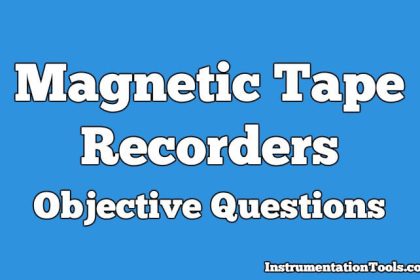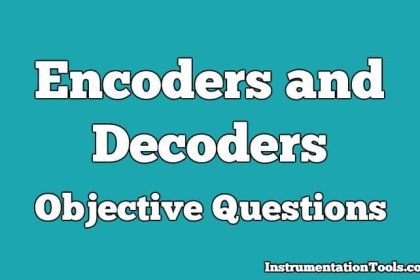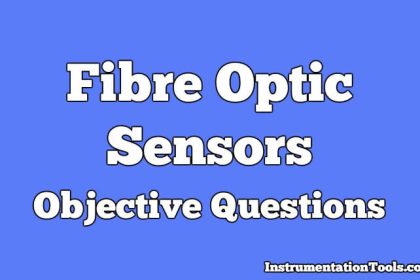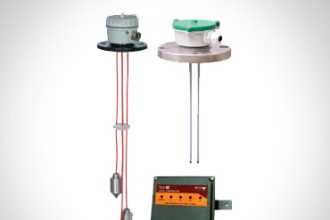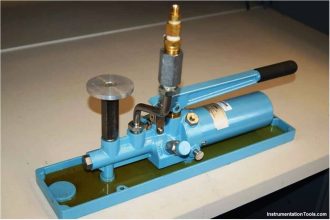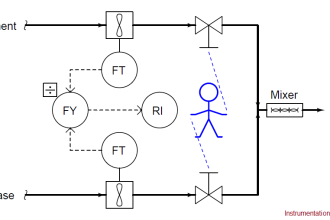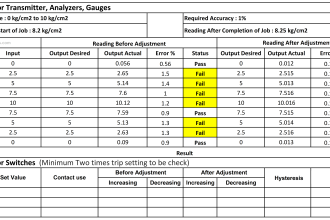In this article, you will find the fiber optic sources and detectors’ objective questions and answers for instrumentation, electrical, and electronics engineers.
Fiber Optic Sources and Detectors Questions
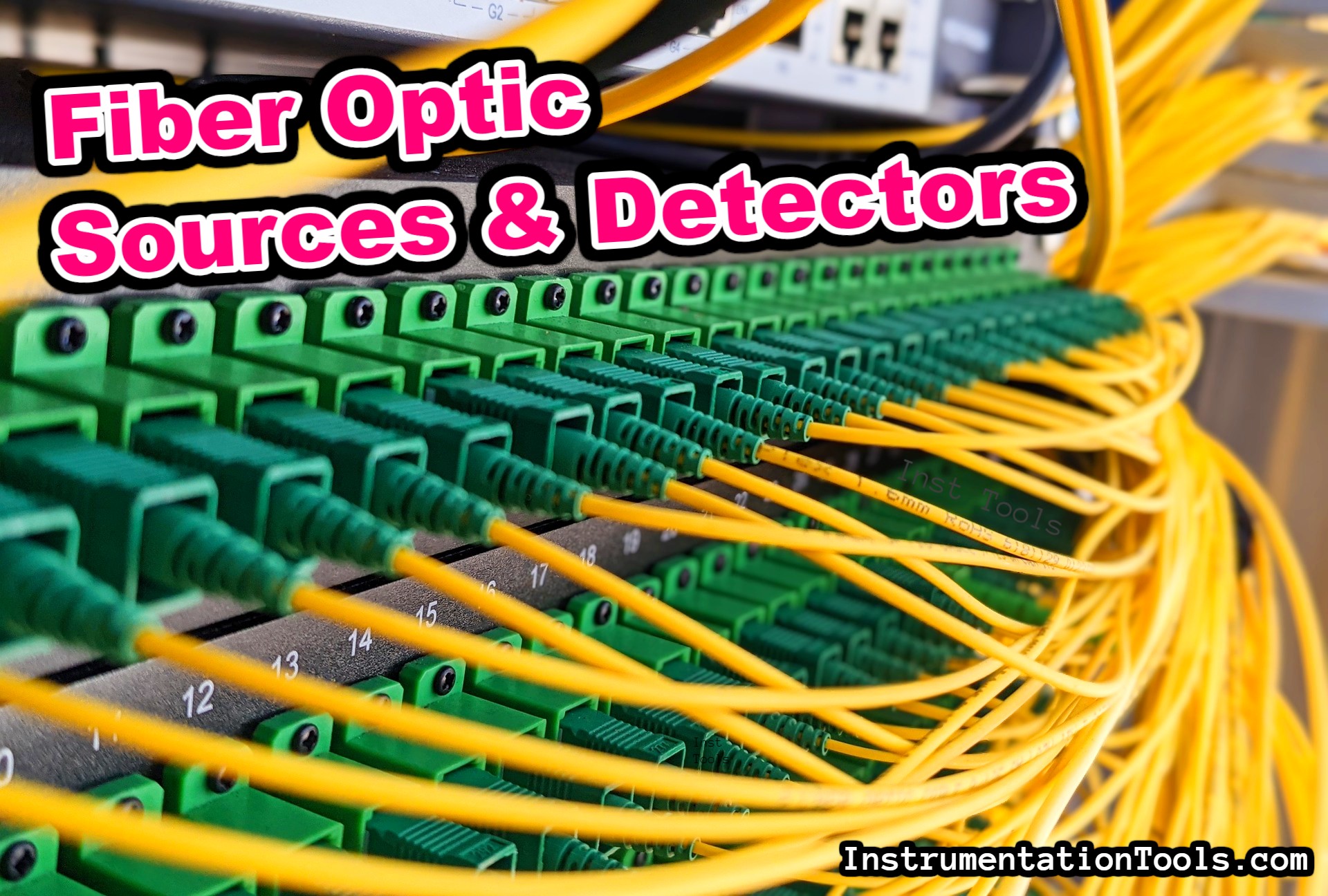
The below list provides all the multiple-choice questions (MCQ) related to the fiber optics.
Answers are available at the bottom of the article.
1. A fiber optic cable plant consists of which of the following parts?
| A) | The fiber optic interconnection equipment only |
| B) | The fiber optic cables associated with the combat system only |
| C) | All of the fiber optic cables and the fiber optic interconnection equipment within the ship |
| D) | The fiber optic cables associated with noncombat systems only |
2. What is the name of the current produced by a photodiode when no light is incident on the device?
| A) | Spill current |
| B) | Photocurrent |
| C) | Threshold current |
| D) | Dark current |
3. When compared to the reverse-bias voltage of a PIN photodiode, the reverse bias of an APD is which of the following sizes?
| A) | A little greater than the PIN’s |
| B) | Much less than the PIN’s |
| C) | Much greater than the PIN’s |
| D) | About the same as the PIN’s |
4. Compared to a high-impedance amplifier, a trans-impedance amplifier provides all but which of the following improvements?
| A) | Bandwidth |
| B) | Dynamic range |
| C) | Sensitivity |
| D) | any of these answers |
5. Which of the following terms is defined as the current produced by an optical detector because of the optical energy incident on its active area?
| A) | Active current |
| B) | Photocurrent |
| C) | Threshold current |
| D) | Incident current |
6. Which of the following are basic types of preamplifiers used in typical fiber optic receivers?
| A) | High-impedance and high-fidelity amplifiers |
| B) | High-impedance and transimpedance amplifiers |
| C) | High-fidelity and transimpedance amplifiers |
| D) | High-impedance, high-fidelity, and transimpedance amplifiers |
7. Which of the following attributes is NOT a desirable attribute of an optical detector?
| A) | Be compatible in size to low-loss optical fibers |
| B) | Contribute high amounts of noise to the system |
| C) | Have a high sensitivity at the operating wavelength of the optical source |
| D) | Maintain stable operation in changing environmental conditions |
8. An analog signal is defined as which of the following signals?
| A) | A continuous signal whose amplitude or some other property varies in direct proportion to some physical variable |
| B) | A discontinuous signal that changes from one state to another in discrete steps |
| C) | A signal generated by an LED |
| D) | A signal generated by an electrical control circuit |
9. When compared to analog transmission, digital systems can tolerate which of the following conditions without affecting system performance?
| A) | All of these answers |
| B) | Large amounts of signal loss and dispersion |
| C) | Source nonlinearities |
| D) | Effects of temperature on system components |
10. Fiber optic splices are typically used in which of the following conditions?
| A) | When repeated connections or disconnections are desired only |
| B) | When repeated connections or disconnections are unnecessary only |
| C) | When low loss connections are required only |
| D) | When repeated connections or disconnections are unnecessary and when low loss connections are required |
11. Which of the following types of sources is typically the most temperature sensitive?
| A) | SLDs |
| B) | ELEDs |
| C) | SLEDs |
| D) | LDs |
12. Which of the following factors does NOT affect the amount of current generated by a photodiode?
| A) | The responsivity of the photodiode at the wavelength of the incident light |
| B) | The data rate of the incoming optical signal |
| C) | The size of the photodiode active area relative to the fiber core size |
| D) | The alignment of the fiber and the photodiode |
13. The term receiver sensitivity has which of the following meanings?
| A) | The range of optical power levels over which the receiver operates within specified values |
| B) | The ratio of the output photocurrent to the incident optical power |
| C) | The minimum amount of optical power required to achieve a specific receiver performance |
| D) | The wavelengths over which the receiver will properly operate |
14. The typical method of source modulation for most analog fiber optic systems is what type of modulation?
| A) | Pulse position |
| B) | Wavelength modulation |
| C) | Intensity modulation |
| D) | Phase modulation |
15. Which of the following components is NOT one of the basic types of LEDs used for fiber optic communication systems?
| A) | Edge-emitting LED |
| B) | Superluminescent diode |
| C) | Avalanche photodiode |
| D) | Surface-emitting LED |
16. For which of the following applications would a transimpedance amplifier typically be used instead of a high impedance amplifier?
| A) | Low-data-rate applications only |
| B) | Low- and moderate-data-rate applications |
| C) | Moderate-data-rate applications only |
| D) | High-data-rate applications |
17. The term detector responsivity has which of the following meanings?
| A) | The wavelengths over which the detector will convert light to electric current |
| B) | The minimum amount of optical power required to achieve a specific receiver performance |
| C) | The range of optical power levels over which the receiver operates within specified values |
| D) | The ratio of the output photocurrent to the incident optical power |
18. The responsivity of an optical detector is constant over wavelength; that is, an optical detector does not absorb some wavelengths better than others.
| A) | True |
| B) | False |
19. Reverse-biased photodetectors are highly linear devices with respect to output photocurrent and input optical power.
| A) | False |
| B) | True |
20. Which of the following definitions best describes the term laser mode?
| A) | The selected wavelengths that the laser emits |
| B) | The condition of the laser, either lasing or not lasing |
| C) | The maximum modulation frequency possible for the laser |
| D) | The maximum angle of the emitted beam from the laser |
21. In fiber optic systems, what are the principal types of detectors used?
| A) | Integrating spheres |
| B) | Photon counters |
| C) | PIN photodiodes and APDs |
| D) | Photomultiplier tubes |
22. In a fiber optic receiver, what is the dominant contributor of electrical noise?
| A) | Output circuitry |
| B) | Postamplifier |
| C) | Optical detector |
| D) | Preamplifier |
23. An optical detector has which of the following purposes?
| A) | To convert an optical signal into an electrical signal |
| B) | To convert an electrical signal to an optical signal |
| C) | To amplify the optical output signal |
| D) | To generate an optical pulse proportional to the input current |
24. Which of the following fiber optic components is responsible for converting the weakened and distorted optical signal back to an electrical signal?
| A) | Fiber optic receiver |
| B) | Fiber optic transmitter |
| C) | Fiber optic coupler |
| D) | Fiber optic amplifier |
25. In a fiber optic system, which of the following is NOT a typical source of noise?
| A) | Noise from the receiver itself |
| B) | Noise from the light source |
| C) | Noise coupled in from adjacent optical fibers in a multifiber cable |
| D) | Noise from the interaction of light with the optical fiber |
26. For fiber optic transmitters, which of the following are typical output interfaces?
| A) | Optical fiber pigtails |
| B) | Single fiber cable pigtails |
| C) | All of these answers |
| D) | Optical connectors |
27. Which of the following items is NOT an example of a digital line code?
| A) | Manchester |
| B) | Non-return-to-zero |
| C) | Return-to-zero |
| D) | Frequency modulation |
28. What topology consists of equipments attached to one another in a closed loop?
| A) | Ring topology |
| B) | Tree topology |
| C) | Star topology |
| D) | Linear bus topology |
29. What type of fiber optic link is the basic building block of all fiber optic systems?
| A) | Loop |
| B) | Point-to-point |
| C) | Point-to-central |
| D) | Branch |
30. What action, if any, will maximize the sensitivity of a fiber optic receiver?
| A) | Minimizing the receiver noise |
| B) | Maximizing the receiver bandwidth |
| C) | Maximizing the receiver dynamic range |
| D) | None of these answers |
31. Which of the following are possible transmitter package types used in Navy shipboard applications?
| A) | Hybrid microcircuit dual inline packages (DIPs) only |
| B) | Hybrid microcircuit dual inline packages, circuit cards, and standalone fiber optic converters |
| C) | Stand-alone fiber optic converters only |
| D) | Circuit cards only |
32. A digital signal can be defined as which of the following signals?
| A) | A signal generated by a laser |
| B) | A discontinuous signal that changes from one state to another in discrete steps |
| C) | A continuous signal whose amplitude or some other property varies in direct proportion to some physical variable |
| D) | A signal generated by an electrical circuit |
33. Compared to SLEDs, ELEDs have all except which of the following properties?
| A) | Are more temperature sensitive than SLED |
| B) | Emit power over a wider spectral range than SLEDs |
| C) | Emit light in a narrower emission angle than SLEDs |
| D) | Couple more power into small NA fibers than SLEDs |
34. The fiber cleaving process includes which of the following actions?
| A) | Cutting the fiber with a cleaver |
| B) | Lightly nicking the fiber and applying tension until it breaks |
| C) | Bending the fiber until it breaks |
| D) | Sawing the fiber with a special fiber saw |
35. Which of the following types of transmitters are typically the most expensive?
| A) | SLEDs |
| B) | SLDs |
| C) | LDs |
| D) | ELEDs |
36. In low and moderate data rate applications, which of the following source types are typically used?
| A) | SLEDs and ELEDs |
| B) | SLEDs only |
| C) | ELEDs only |
| D) | Lasers |
37. For which of the following applications would an APD rarely be used?
| A) | Low- and high-data-rate applications |
| B) | Low- and moderate-data-rate applications |
| C) | none of these answers |
| D) | Moderate- and high-data-rate applications |
38. In what topology is each equipment connected to a common center hub?
| A) | Ring topology |
| B) | Tree topology |
| C) | Linear bus topology |
| D) | Star topology |
39. What does the term lasing threshold mean?
| A) | The polished or cut surfaces at each end of the active stripe in the laser |
| B) | The shortest wavelength that the laser emits |
| C) | The lowest drive current level at which the output of the laser results primarily from stimulated emission |
| D) | The front step of the laser chip |
40. What are the two basic classifications of fiber optic links?
| A) | High power and low power |
| B) | Return-to-zero and non-return- to zero line coded |
| C) | Digital and analog |
| D) | Amplitude modulated and frequency modulated |
41. Which of the following items is NOT an example of a digital line code?
| A) | Manchester |
| B) | Non-return-to-zero |
| C) | Return-to-zero |
| D) | Frequency modulation |
42. For lasers that are to be operated under widely changing thermal conditions, what device is normally included in the laser package?
| A) | Automatic overload protection circuitry |
| B) | Low-pass filter |
| C) | Variable attenuator |
| D) | Thermo electric cooler |
43. In shipboard applications with moderate data rates (50 to 200 Mbps), which of the following source types will typically be used?
| A) | 1300-nm LEDs only |
| B) | 850-nm and 1300-nm LEDs |
| C) | Lasers |
| D) | 850-nm LEDs only |
44. When installing fiber optic cables aboard Navy ships, which of the following precautions should you take?
| A) | All of these answers |
| B) | Never bend an optical cable in a bend smaller than the cable’s minimum bend radius |
| C) | Never pull a fiber optic cable over or through sharp corners or cutting edges |
| D) | Always clean fiber optic connectors before mating them |
45. What kind of circuitry do most lasers have that compensates for the sensitivity of the laser to its environment?
| A) | Automatic overload protection circuitry |
| B) | Low-pass filter circuitry |
| C) | Linearization circuitry |
| D) | Power control circuitry |
46. The gain of an APD can be changed in what way?
| A) | By changing the modulation format of the incoming signal |
| B) | By changing the input power of the optical signal |
| C) | By changing the data rate of the incoming optical signal |
| D) | By changing the reverse-bias voltage |
47. Which of the following types of sources have very similar semi-conductor designs?
| A) | SLEDs, SLDs, lasers |
| B) | ELEDs, SLDs, lasers |
| C) | SLEDs, ELEDs, lasers |
| D) | SLEDs, ELEDs, SLDs |
48. What line code, if any, makes the most efficient use of system bandwidth?
| A) | Non-return-to-zero |
| B) | None of these answers |
| C) | Return-to-zero |
| D) | Manchester |
49. Which of the following is NOT a typical part of a fiber optic receiver?
| A) | Output signal conditioning circuity |
| B) | Optical detector |
| C) | Thermo electric cooler |
| D) | Low-noise amplifier |
50. Which of the following types of noise are introduced by the fiber optic receiver?
| A) | Thermal noise only |
| B) | Quantum noise only |
| C) | Thermal noise, shot noise, and quantum noise |
| D) | Shot noise only |
51. A PIN photodiode usually operates in what way?
| A) | No bias voltage applied |
| B) | none of these answers |
| C) | Forward-bias voltage applied |
| D) | Reverse-bias voltage applied |
52. Single fiber butt-jointed connections generally consist of which of the following parts?
| A) | Two plugs and an adapter |
| B) | One plug and two adapters |
| C) | Ferrule and alignment clip |
| D) | Plug and receptacle |
53. What fiber mechanisms weaken and distort the optical signal launched into the fiber?
| A) | Scattering, absorption, and dispersion |
| B) | Scattering, radiation, and absorption |
| C) | Scattering, reflection, and refraction |
| D) | Dispersion, radiation, and absorption |
54. The term dynamic range has which of the following meanings?
| A) | The wavelengths over which the receiver will properly operate |
| B) | The ratio of the output photocurrent to the incident optical power |
| C) | The range of optical power levels over which the receiver operates within specified values |
| D) | The minimum amount of optical power required to achieve a specific receiver performance |
55. Analog transmission would most likely be used in which of the following shipboard applications?
| A) | Local area networks |
| B) | Computer interconnections |
| C) | Long-haul communications |
| D) | Video links |
56. What topology consists of a single transmission line that is shared by a number of equipments?
| A) | Tree topology |
| B) | Ring topology |
| C) | Star topology |
| D) | Linear bus topology |
57. What type of fiber optic link consists of two simple point-to-point links transmitting in opposite directions?
| A) | Composite link |
| B) | Full duplex link |
| C) | Simplex link |
| D) | Total link |
58. Transmitters containing what source type, if any, will typically require the most complex circuitry?
| A) | LD |
| B) | SLED |
| C) | None of these answers |
| D) | ELED |
59. In shipboard applications with low data rates (0 to 50 Mbps), which of the following source types will typically be used?
| A) | Either 850-nm LEDs or 1300 nm LEDs depending on design |
| B) | 1300-nm LEDs only |
| C) | Lasers |
| D) | 850-nm LEDs only |
60. What topology consists of a transmission line that branches or splits?
| A) | Ring topology |
| B) | Tree topology |
| C) | Linear bus topology |
| D) | Star topology |
Click Here for Answers
If you liked this article, then please subscribe to our YouTube Channel for Electrical, Electronics, Instrumentation, PLC, and SCADA video tutorials.
You can also follow us on Facebook and Twitter to receive daily updates.
Next Quiz:
- Control Valve Questions
- Ohms Law MCQ Questions
- Measurements Quiz Questions
- Smart Sensors Quiz Questions
- Process Control Objective Questions

